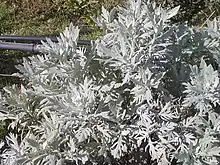| Senecio leucopeplus | |
|---|---|
 | |
| Scientific classification | |
| Kingdom: | Plantae |
| Clade: | Tracheophytes |
| Clade: | Angiosperms |
| Clade: | Eudicots |
| Clade: | Asterids |
| Order: | Asterales |
| Family: | Asteraceae |
| Genus: | Senecio |
| Species: | S. leucopeplus |
| Binomial name | |
| Senecio leucopeplus Cabrera, 1941 | |
| Synonyms[2] | |
|
Senecio candolleanus Hook. & Arn. | |
Senecio leucopeplus is a species of flowering plant in the family Asteraceae. It is native to northeastern Argentina. The species is currently extinct in the wild, as the last 2 specimens found in the wild disappeared in 2007. There are currently two specimens in cultivation at the Pillahuincó Botanic Garden.[1][2][3]
References
- 1 2 e Villalobos, A. (2008). "Senecio leucopeplus". IUCN Red List of Threatened Species. 2008: e.T133711A3874098. doi:10.2305/IUCN.UK.2008.RLTS.T133711A3874098.en. Retrieved 2023-05-30.
- 1 2 "Senecio leucopeplus Cabrera". www.worldfloraonline.org. Retrieved 2023-05-30.
- ↑ "Senecio leucopeplus Cabrera | Plants of the World Online | Kew Science". Plants of the World Online. Retrieved 2023-05-27.
This article is issued from Wikipedia. The text is licensed under Creative Commons - Attribution - Sharealike. Additional terms may apply for the media files.
